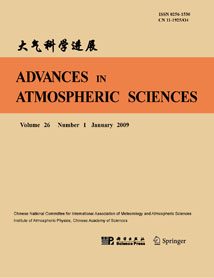THE PROPAGATION CHARACTERISTICS OF INTERANNUAL LOW-FREQUENCY OSCILLATIONS IN THE TROPICAL AIR-SEA SYSTEM
- Manuscript received: 1988-10-10
- Manuscript revised: 1988-10-10
Abstract: The time series of sea surface temperature (SST), sea level pressure (SLP), zonal wind (U) and total cloudiness (CA), for the period of 1950-1979, over a 8o×8o grid-point latitudinal belt between 32oS and 32oN are made from COADS (Comprehensive Ocean-Atmosphere Data Set). The time harmonic analysis and power spectra analysis show that there exist quasi-biennial oscillation (QBO), three and half years oscillation (SO), five and half years oscillation (FYO) and eleven years oscillation (EYO) in these time series. The main propagation characteristics of these interannual low-frequency oscillations are as follows:(1) The variance analysis of SST shows that there is an active region of QBO and SO (with maximum variance), coming from the southwestern part of the subtropical Pacific, stretching eastward up to the west coast of South America, and then northward to the eastern equatorial Pacific. The QBO and SO disturbances of SST follow the same route and cause the anomaly of SST (El Nino and period of cold water) in the eastern equatorial Pacific.(2) Either the QBO or SO of SST can cause El Nino events, although it is easier when they are situated in the same phase of warm water at the eastern equatorial Pacific. The FYO of SST seems to be a standing oscillation. It plays an important role on the formation of strong El Nino events or strong cold water events.(3) The QBO and SO of U propagate eastward along the equator. The origin of QBO and SO may at least be traced as far as the western Indian Ocean. While they propagate along the equator, it strengthens two times at 90oE and the western Pacific, respectively. Like SST, the FYO of U is somehow a standing oscillation.(4) The Oscillations of U have a good coupling relationship with those of SST, while they propagate. When the QBO and SO of SST move to the east side of the eastern equatorial Pacific, it is the time for the QBO and SO of U to enter into the east part of the western Pacific.It is clear that, when we do research work on the formation of El Nino events, our consideration would not be confined to the tropics, it should cover the subtropical region in the southern Pacific. The features of the circulation and other oceanic states in this area are very important to the El Nino events.















 AAS Website
AAS Website 
 AAS WeChat
AAS WeChat 
 DownLoad:
DownLoad: